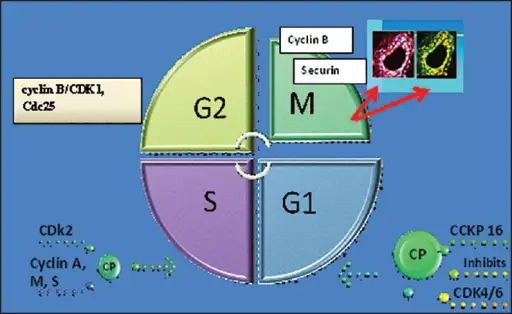
Cell Cycle. Displays a simplistic diagram of the cell cycle consisting of four distinct phases: Gap1 (G1)-phase, synthesis (S)-phase, Gap2 (G2)-phase (collectively known as interphase), and mitosis (M)-phase. The M-phase is itself composed of two tightly coupled processes: mitosis, in which the cell's chromosomes are divided between the two daughter cells, and cytokinesis (two cells, red arrows), in which the cell's cytoplasm divides in half, forming distinct cells. Growth factors, nutrients, cell size, and DNA damage can act as possible restriction points. CPs are control mechanisms that ensure the fidelity of cell division in eukaryotic cells. In G1, the (restriction CP) main player is CDK inhibitor p16 (CCK p16). This protein inhibits CDK4/6 and safeguards it so that that it can no longer interrelate with cyclin D1 to cause cell cycle progression. The second CP is located at the termination of G2 phase; this CP involves an activating phosphatase known as Cdc25, which under favorable circumstances removes the inhibitory phosphates present within the mitosis promoting factor (a term for the cyclin B/CDK1 complex). Metaphase or spindle phase or mitosis phase CPs require cyclin B, which harbors a destruction box (D-box) and breaks down securin; the breakdown of securin then allows progression of the cell cycle. Many other CPs are present in the cell cycle but are not shown here. Tumor-suppressor Genes, Cell Cycle Regulatory Checkpoints, and the Skin. Abreu Velez AM, Howard MS - North American journal of medical sciences (2015). Not Altered. CC.
The cell cycle involves four phases:
- G1 phase: The cell increases in size
- S phase: Copies its DNA
- G2 phase: Prepares to divide
- M phase: Mitosis
